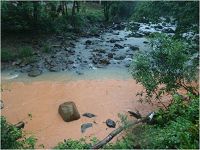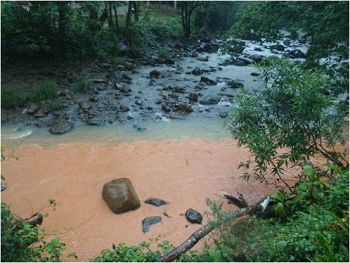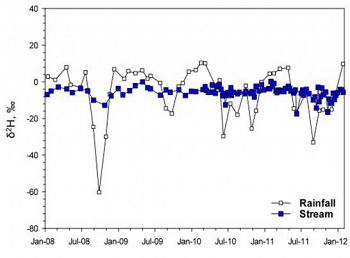ARCHIVED CONTENT: In December 2020, the CZO program was succeeded by the Critical Zone Collaborative Network (CZ Net)
×
Old Water from New Storms in Tropical Streams
One persisting question in hydrology is how do catchments store ‘old’ water for long periods (months or even years), but then release it almost instantaneously (within minutes) during storm events?
The photograph on the top right shows two streams in the Luquillo Critical Zone Observatory merging. When waters mix, their individual chemical and isotopic signatures are combined. The figure on the bottom right shows the isotopic signal of stream water and rainwater for four years in the LCZO.
The rainwater isotopic composition is highly variable (open circles). The geochemical signal in the stream water (blue squares) appears ‘buffered’ by a large pool of old, isotopically distinct water. Such a scenario was not expected in a tropical setting like Puerto Rico where quickflow (‘new water’) was previously thought to dominate the total stream flow flux. Evaristo et al. (in prep.), with data from M. Scholl (USGS – Figure bottom right), have posed this old question but have a new solution that potentially resolves this paradox of where and how this might happen.
We propose that prompt discharge of ‘old’ water is related to an isotopically distinct pool of water in soils that is loosely bound and associated with plants.
Anyone observing a stream during a storm can see that the water becomes muddy and the water level rises. The water level rises especially quickly in Puerto Rico and other wet tropical areas. The photograph at the top shows two streams merging. One stream carries muddy water from a storm event in the headwaters. When the water level rises so quickly, it is assumed that rain is the water that causes the stream level to rise. In the bottom figure, however, we see that the rain water (open circles) and the stream water (blue squares) are isotopically distinct, which indicates that the water in the stream is mostly ‘old’ water that has been sitting in soil pore spaces for days or even months. The large amount of old water in soil mixes with rainwater and smooths out the rainwater signal in the stream.
Isotopic signatures of rainfall and throughfall
Two streams mixing in the Luquillo CZO.
News Category:
RESEARCH
Explore Further





